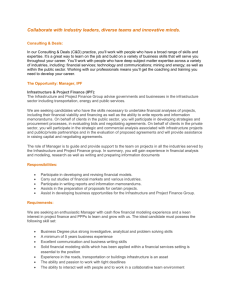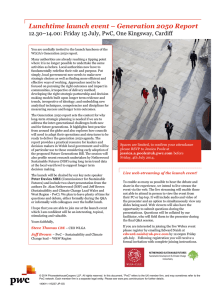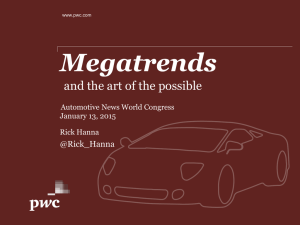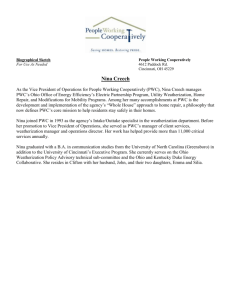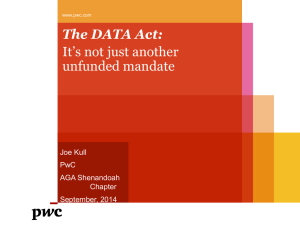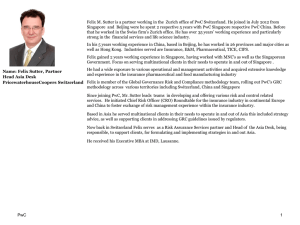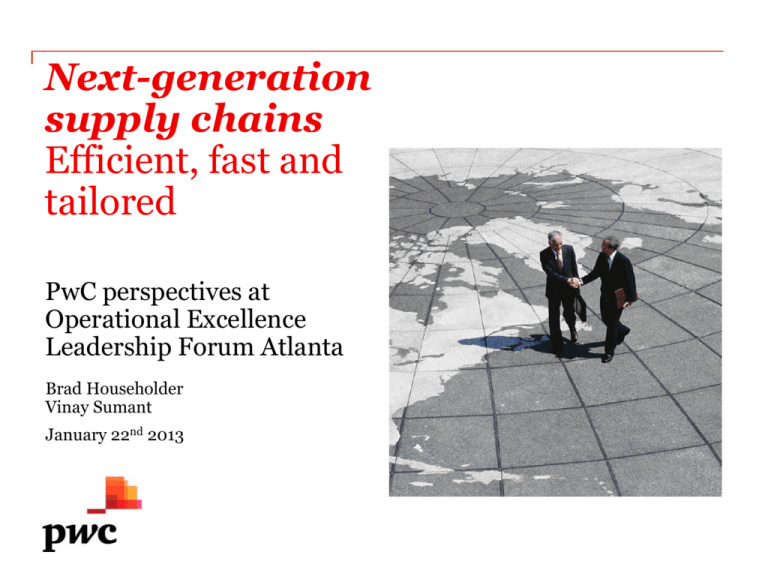
Next-generation
supply chains
Efficient, fast and
tailored
PwC perspectives at
Operational Excellence
Leadership Forum Atlanta
Brad Householder
Vinay Sumant
January 22nd 2013
PwC
Six Trends: The emergence of global, strategic supply chain
management as a competitive imperative
Based on PwC’s 2012 Annual CEO Survey, Global Supply Chain Survey 2013, and
benchmarking research
2
Companies that treat their
supply chain as a strategic
asset achieve higher
performance across
multiple key metrics
1
6
PwC
3
Leaders make greater use
of segmentation and
“tailored” supply chains to
focus performance on
customer needs
Pressures continue to mount on
supply chains to be “good at
everything”
Interest in nextgeneration
technologies and
sustainable supply
chains is growing
4
5
Leaders invest
more heavily in
differentiating supply
chain capabilities
Leaders retain global
control of core
strategic functions
Next-generation supply chains
PwC perspectives on leading operational performance
Slide 2
A note on Leaders vs. Laggards: Defining leading
performance and practices
Best-in-Class-Company Research: Cross-industry analysis of detailed supply chain benchmark data
Composite Supply Chain
Performance
Middle
50%
Delivery performance to commit date
Upside production flexibility
Total supply chain management cost
Cash-to-cash cycle time, and
Inventory days of supply
Bottom
25%
Top
25%
Median
Companies
Worst-in-Class
Companies
Statistical correlation to
actual financial
performance and SC
practice and complexity
benchmark data
Best-in-Class
Companies (BICCs)
Global Supply Chain Survey 2013: Survey of over 500 companies
Financial
Performance Index
EBIT Margin
Revenue Growth
Supply Chain
Performance Index
Inventory Turns
Delivery Performance
PwC
Basic Capabilities
Bottom 20%
by Industry
Top 20% by
Industry
Combined
Score
(Common between Leaders
and Laggards)
Laggards
Industry
Laggards
Industry
Leaders
Next-generation supply chains
PwC perspectives on leading operational performance
Leaders
Differentiating
Capabilities
(Leaders hold more
important than Laggards)
Slide 3
Pressures continue to mount on
supply chains to be “good at
everything”
PwC
Economic cycles
The economic cycles of the past decade have been the driving
force behind the evolution of supply chains
The Great
Recession
Next
generation
supply chains
2008
Globalization,
cost
PwC
Japan Tsunami
Arab Spring
2009
Working
capital
2010
Responding to
the upturn
Next-generation supply chains
PwC perspectives on leading operational performance
2011
Operational
flexibility
Slide 5
Companies that treat their supply
chain as a strategic asset achieve
higher performance across multiple
key metrics
PwC
Overall, less than half of the companies surveyed see their
supply chain as a strategic asset, but industry differences
are telling
Supply chain seen as strategic asset
[% of participants]
Technology and
Telecom
9%
56%
Automotive
50%
Industrial Products
46%
36%
43%
Chemicals and Process
Pharmaceuticals and
Life Sciences
41%
Consumer Goods
40%
Other
26%
Our supply chain…
… supports the company in constantly outperforming the market
… is at an advantage to peers
… is at parity with industry peers
… is at a disadvantage to industry peers
PwC
Next-generation supply chains
PwC perspectives on leading operational performance
Slide 7
Leaders are more than twice as likely to treat their supply
chain as a strategic asset
% of Leaders and Laggards viewing
supply chain as strategic asset
Overall
Technology & Telecom
Industrial
Laggards
Healthcare / Pharma
Leaders
Consumer Goods
Chemicals / Process
Automotive
0%
PwC
20%
40%
60%
80%
Next-generation supply chains
PwC perspectives on leading operational performance
100%
Slide 8
There is a significant opportunity for Laggards to improve
operational performance and to follow the Leaders
Average EBIT
margin
Average delivery
performance (OTIF)
Opportunity
Average inventory turns
per year
Opportunity
+30%
Opportunity
+8%
16%
89%
+87%
96%
79%
12%
7%
Laggards
PwC
Average
Leaders
Laggards
Average
Leaders
Next-generation supply chains
PwC perspectives on leading operational performance
Laggards
Average
Leaders
Slide 9
Leaders make greater use of
segmentation and “tailored” supply
chains to focus performance on
customer needs
PwC
Leaders operate more supply chain configurations to
achieve a competitive advantage
# supply chain
configurations
# configurations
per channel
# channels
+40%
+55%
-10%
4.3
2.3
3.1
Laggards
1.4
Leaders
Leaders operate more
supply chain
configurations
PwC
2.1
2.0
Laggards
Leaders
Leaders are more focused
than Laggards since they
operate in less channels
Next-generation supply chains
PwC perspectives on leading operational performance
Laggards
Leaders
Leaders operate up to 50%
more configurations per
channel than Laggards
Slide 11
What does “segmentation” mean: The “one-size-fits-all” vs.
the differentiated supply chain architecture
Supply chain
requirements
Market
characteristics
Geography/Country
Supply chain
architecture
Supply chain configuration 1
Delivery
performance
Supply chain configuration 2
Supply chain configuration 3
Flexibility/Responsiveness
Market/
Demand
Channel/
Market
Delivery
performance
Product/
Technology
One-size-fits-all
supply chain configuration
Flexibility/Responsiveness
Definition: Instead of deploying a one size fits all approach many companies use an operating model that constitutes of different Supply Chains Configurations. Each Supply Chain Configuration is optimized
and differentiated in the area plan, source, make, deliver to service specific business requirements. For instance:
•
An industrial manufacturer might have 2 different SC configurations: 1 for complex / high-range products and 1 for standardized / lower cost products. Each SC configuration might serve the same
customers and might source from the same suppliers, but could use different production locations and, potentially different distribution networks.
•
A large retailer might have 2 different SC configurations: 1 for physical storefront and 1 for on-line shopping.
•
Note: Reverse Supply Chain is out of scope
PwC
Next-generation supply chains
PwC perspectives on leading operational performance
Slide 12
Leaders invest more heavily in
differentiating supply chain
capabilities
PwC
The “Best-in-Class Company” research provides
additional insight on differentiating practices
Supply Chain practice maturity…
…which contributes to financial performance
Plan
Source
Stages of Maturity
Make
Deliver
Return
Enable
1
2
3
4
Degree of SC integration
…drives Supply Chain performance…
Composite Supply Chain
Performance
Delivery performance to commit date
Upside production flexibility
Total supply chain management cost
Cash-to-cash cycle time, and
Inventory days of supply
PwC
Middle
50%
Bottom
25%
Median
Companies
Worst-in-Class
Companies
Top
25%
Best-in-Class
Companies (BICCs)
Next-generation supply chains
PwC perspectives on leading operational performance
Slide 14
Key differentiating practices from BICC research
and SC Trends Survey
• Collaborate more with customers and suppliers in the
development of long range strategic plans
PLAN
• Integrate key customers and suppliers into the supply
planning process, and have clear rules and requirements for
managing demand/supply exceptions
• Extensive sharing of data, including real-time electronic
exchange
BICC companies plan for their
extended supply chains
BICC companies share significantly
more data with suppliers
SOURCE
• Collaborating on joint process improvements
• Extensive use of pull-based mechanisms
• Late stage product customization
• Engagement of manufacturing function in product design and
development
• Differentiated service levels , lead times, and customer
policies
BICC companies integrate
manufacturing and supply chain
considerations into product design
MAKE
BICC companies tailor supply chains
to specific customer segment
requirements
DELIVER
• Late stage customization
• Explicitly defined integrated process architecture
• Explicitly defined links to product development, sales,
marketing, and finance functions
• End-to-end performance metrics and targets
PwC
ENABLE
BICC companies actively manage
cross-functional integration,
performance, and complexity
Next-generation supply chains
PwC perspectives on leading operational performance
Slide 15
Operational Impact of Next
Generation Supply Chains
PwC
Treat supply chain as a strategic asset with focus on revenue
and profit planning and contribute to an Optimal RONA
RONA
Net profit margin
Sales
competencies
Asset turnover
What do we deliver to our clients?
Sales
COGS
Conversion cost
• Delivery reliability
• Segmentation
• Product mix
Expenses
Fixed assets
Working capital
Material cost
• Yield, scrap
• Changeover
• Labour
Inventory
• Internal and external
• Total cost of ownership
• Cost-to-serve
• Machine utilisation
• Asset deployment
Finance
competencies
Cash
• Inventory parameters/tactics
• Excess and obsolete stock
• Cash-to-serve
*Terminology based on SCOR
Plan*
Plan
Tactics
Processes
• Balancing capacity • Process redesign
vs. working capital
and service levels
Deliver
and implementation
of nest generation
S&OP / IBP
Tactics
Source*
Make*
Deliver*
Enable*
• Organisational
redesign
Make
Tactics
Tactics
Processes
• Manufacturing strategy
• Manufacturing footprint
• Operational excellence (Lean,
Processes
• Strategic sourcing • Procure-to-pay
• Contract and supplier process redesign
management
• Procurement
organisational
• Procurement
redesign
excellence
• Spend analysis
PwC
design
• Continuous improvement
• Operations roadmap
• Factory layout
redesign
• Warehouse design • Lean warehousing
• Make or buy decisions • Transport
optimisation
redesign
Source
Processes
• Distribution network • Order-to-cash process
Enable
Six Sigma, TPM)
• Shop floor planning & control
• Maintenance management
• OEE management
• Quality management
Next-generation supply chains
PwC perspectives on leading operational performance
• Define supply chain strategy and organisation
• Supply chain assessment
• Profitability management (e.g. cost-to-serve, portfolio)
• Performance management
• Responsiveness increase initiatives for business
partners (customers, suppliers, contract manufacturers
etc.)
Slide 17
Next generation S&OP is about making strategic
decisions for revenue and profit planning
S&OP
Strategic Planning
Business Planning
Forecasting
Customer
&
Co-planning
Demand
Planning
Strategic S&OP
Inventory
Planning
Capacity
Planning
Supply
Planning
Supplier
Co-planning
Tactical S&OP
IT Enablers
Factory Planning and Execution
Includes assessment, metrics and analytics in each of the functional areas
PwC
Next-generation supply chains
PwC perspectives on leading operational performance
Slide 18
Next generation S&OP includes several scenario
modeling based on strategic decisions for revenue
and profit planning
Business Strategy and
Supply Chain Strategy
Alignment
Revenue and Profit Planning
Decisions
• P&L Targets
• RONA Targets
• Volume Targets
• Service Level Targets
• Product / Channel Mix
• Pricing, Discounts, Rebates etc.
• Advertising and Promotions
Scenarios
Supply and Cost Planning
Decisions
• Supply and Inventory policies
• Sourcing options
• Conversion costs
• Direct Materials
• CAPEX
• OPEX
PwC
•
•
•
•
•
•
Pricing
Product / Channel Mix
Capacity Scenarios
Sourcing alternatives
Cost alternatives
Foreign exchange
implications
• Enables Integrated Business
Simulation
and Scenario
Comparison
Planning process with clear cross
functional roles and
responsibilities
• Supported by Integrated
Technology Tools
• Explicit business and process
KPIs
• Single set of data for reporting
and analysis
Next-generation supply chains
PwC perspectives on leading operational performance
Slide 19
Move needle towards next generation S&OP via
collaborative and continuous scenario planning
Strategy
Stage 1: Reacting
Stage 2: Anticipating
Stage 3: Collaborating
Stage 4: Orchestrating
Section 1: Goals
Development of an
operational plan
Demand and supply
matching
Profitability
Demand sensing, and
conscious trade-offs for
demand shaping to drive an
optimized demand response
Section 2: CrossFunctional
Alignment
Supply chain-driven process,
with a strong sales or
operational bias leading to
imbalance, lack of clarity as
to the goal of S&OP.
Supply chain-driven process
for purposes of achieving
optimum forecast and supply
response to demand.
Supply chain becomes the
S&OP orchestrator, and
business functions take
ownership of input, output
and results, looking at
financial impact of decisions
Business ownership at
multiple levels, with strong
participation from executives
and finance. Collaboration
extends beyond the
enterprise to achieve end-toend value.
Section 3: Process
and Technology
Emerging process,
inconsistent and marginally
effective. Often more of a
sales review meeting. Tools
are mainly Excel and ERP.
Formal, structured process.
One-size-fits-all approach.
Tools extend to include
forecasting, SC planning and
inventory optimization
Process tailored to business
model and needs. Dialogue,
and start of use of tools,
around what-if analysis for
demand shaping, financial
reconciliation and cost to
serve
Process becomes balanced,
dynamic and event driven.
Strong connection to
strategic planning and
execution. Tools also support
risk-value trade-offs, price
optimization and complex
simulation
Balance S&OP
Increase in organizational Balance
Source: Gartner (October 2010)
PwC
Next-generation supply chains
PwC perspectives on leading operational performance
Slide 20
Making change happen
PwC
Supply chain
value driver
Leading performers do not follow “knee jerk” reactions to
the pressures on their supply chains, but follow methodical,
roadmaps for change
Maximum
delivery
performance
Minimised
costs
Maximum
volume
flexibility and
responsiveness
Complexity
management
Minimised risks
Tax
optimisation
and efficiency
Sustainability
Value creation
Path to supply chain value creation
Activated value drivers
PwC
Next-generation supply chains
PwC perspectives on leading operational performance
Slide 22
Leaders have clear objectives and structure for
how they manage supply chain transformation
Understand the type of change needed
Follow a comprehensive approach
Impact on business performance
Introducing new ways of competing
in your industry or changing your
basis of competition.
SC
Innovation
SC
Excellence
SC
Improvement
Achieving industry-leading
performance in service, cost,
or quality.
Incremental year-on-year
performance improvements.
Effort / investment required
PwC
Next-generation supply chains
PwC perspectives on leading operational performance
Slide 23
Summary: “Strategic” supply chains
have emerged as a key source of
competitive advantage
1.
Treat the supply chain as a strategic asset
2.
Have an explicit supply chain architecture that carefully tailors
different configurations to different segments
3.
Understand the critical capabilities and practices for leading
performance and strive to the best at them
4.
Focus on owning the key strategic operational levers, and find
partners who are the best at non-key ones
5.
Adopt a disciplined, methodical approach to change, but
6.
Stay awake, the rules will continue to change!
PwC
Next-generation supply chains
PwC perspectives on leading operational performance
Slide 24
© 2013 PwC. All rights reserved. "PwC" refers to
PricewaterhouseCoopers LLP, a Delaware limited liability
partnership, which is a member firm of PricewaterhouseCoopers
International Limited, each member firm of which is a separate
legal entity. This document is for general information purposes
only, and should not be used as a substitute for consultation with
professional advisors.
PwC
Additional slides
PwC
Leaders retain global control of core
strategic functions
• Leaders are more likely to retain control of
core strategic functions
• Leaders tend to operate strategic functions
with a global perspective, but execution with a
regional focus
PwC
Supply chain Leaders keep core functions under global
control and focus on regional execution
Leader’s
organisational model
Leaders’ geographic
organisation
0%
% of global and regional functions
20%
40%
60%
80%
100%
New product development
70%
Strategic procurement
66%
Supply chain centre of excellence
60%
S&OP
54%
Manufacturing and assembly
Demand planning
24%
Strategic functions
Global
49%
Execution functions
Regional
38%
34%
Customer order desk
24%
Service
24%
Operational procurement
22%
Warehousing
20%
Inbound and outbound logistics
18%
Regional: Regional and local functions
Global: Global BU (cross region and cross enterprise)
Global
Regional
Strategic functions: Demand Planning, S&OP, Strategic Procurement, New Product Development, Supply Chain Centre of Excellence
Execution functions: Operational Procurement, Customer Order Desk, Inbound and Outbound Logistics, Manufacturing and Assembly, Service
PwC
Next-generation supply chains
PwC perspectives on leading operational performance
Slide 28
Technology and Telecomm industry operates with the
highest degree of global functions
Geographic organisation of
supply chain functions
Local
Global
Regional
Demand planning
Plan
S&OP
Strategic procurement
Source
Operational procurement
Manufacturing and assembly
Make
Service
Customer order desk
Deliver
Warehousing
Inbound and outbound logistics
New product development
Enabler
Supply chain centre of excellence
PwC
Automotive
Chemicals / Process
Consumer Goods
Healthcare
/ Pharma
Pharma/Life
Sciences
Industrial
Technology/Telecom
TMT
Slide 29
Interest in next-generation
technologies and sustainable supply
chains is growing
• Visibility and sustainability are increasing
rapidly in importance to CEOs and supply
chain executives across industries
PwC
Supply chain trend: Implementing techniques to automate
and increase transparency
High importance1 of automation
in 2013 [%]
Pharmaceuticals and
Life Sciences
Increase by
20152 [%]
54
% Increase by
2015 vs. 2013
(+43%)
Technology and Telecom
51
(+49%)
Chemicals and Process
50
(+38%)
Retail and Consumer Goods
54
(+10%)
Automotive
53
(+9%)
Industrial
41
Note
1) % participants who judge trend as critical or significant in 2013
2) % participants who say that trend is significant, critical or moderate in 2013 and who say that importance will
increase by 2015 or who indicate critical or significant for 2013 and indicate that it will stay same for the next
two years
PwC
Next-generation supply chains
PwC perspectives on leading operational performance
(+39%)
Importance increase by
≥ 20%
10% and < 20%
≤ 10%
Slide 31
Agreement of supply chain to adhere to highest ethical data
is the most important practice
Importance of
sustainability
Important practices for sustainability adherence
Internal carbon footprint optimisation and improvement
Agreement to adhere to highest ethical standards*
42%
Responsible footprint and procurement framework
Effective track and trace capabilities*
Integrated risk management
Peer cooperation and strategic alliances to align on target*
Highly important
(critical and significant)
Return supply chain to manage recycling
Less important
PwC
Next-generation supply chains
PwC perspectives on leading operational performance
Slide 32
Supply chain trend: Making the supply chain more
sustainable
High importance1 of
sustainability in 2013 [%]
% Increase by
2015 vs. 2013
Pharmaceuticals and
Life Sciences
50
(+26%)
Automotive
50
(+22%)
Chemicals and Process
42
Retail and Consumer Goods
Industrial Products
Technology and Telecom
39
32
33
Note
1) % participants who judge trend as critical or significant in 2013
2) % participants who say that trend is significant, critical or moderate in 2013 and who say that
importance will increase by 2015 or who have indicated critical or significant for 2013 and indicate
that it will stay same for the next two years
PwC
Increase by
20152 [%]
Next-generation supply chains
PwC perspectives on leading operational performance
(+40%)
(+38%)
(+60%)
(+43%)
Importance increase by
≥ 20%
10% and < 20%
≤ 10%
Slide 33
Leaders focus on differentiating capabilities which provide
the platform for superior performance
Supply chain value driver
Top three differentiating practices of Leaders
Maximum delivery
performance
1. Collaboration with key customers on planning (e.g., effective forecasting)
2. End-to-end supply chain planning and visibility
3. Vendor-managed-inventory (VMI) direct-replenishment model
Minimized costs
1. Best-cost country sourcing
2. Differentiated order-to-delivery time
3. Differentiated service level including potential reduction
Maximum volume
flexibility and
responsiveness
1. Internal capacity flexibility 80%-120%
2. Flexible shift models/payment structure
3. Regional supply chain set-up
Minimized risks
1. Regular review of suppliers’ financial risk and mitigation through
risk-sharing partnerships
2. Multiplication of sources and sole-sourcing avoidance
3. Visibility over short-term supply through order traceability, VMI…
Complexity management
1. Late stage product customization
2. Develop multi-skilled employees in order to cope with complexity
3. Use of distributors and other channel partners
Sustainability
1. Responsible supply chain partner footprint and procurement framework
2. Integrated risk management
3. Internal carbon footprint optimization and improvement
Tax optimization
and efficiency
1. Manufacturing and assembly optimization (toll manufacturing)
2. IP and patent royalty optimization
3. Localization of procurement organization in tax efficient countries (e.g., Singapore,
Switzerland, Cayman Islands…)
PwC
Next-generation supply chains
PwC perspectives on leading operational performance
Slide 34
51% of the Leaders focus on differentiating supply chain
capabilities
Prioritisation of differentiating
supply chain capabilities
+18%
Laggard
Leader
% leaders/laggards who perceive the capability as very important
PwC
Next-generation supply chains
PwC perspectives on leading operational performance
Slide 35

